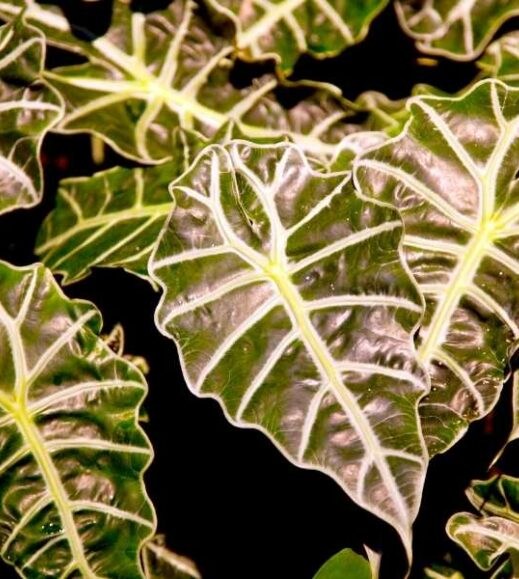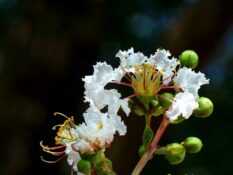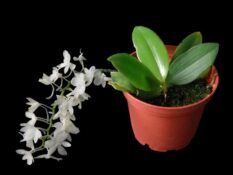Alocasia (also known as Elephant's ear) is a genus of plants that consists of over 70 species. Its origin can be traced back to South East Asia, Australia, and the Pacific Islands, although some species are now grown around the world in gardens, outdoors, and indoors. Most Alocasias have large leaves with wavy margins. The coloring of the leaves ranges from dark green to light green, sometimes with purple or silver markings, and in some varieties, even spotted!
Alocasia plants are also known for their unique shape, resembling an elephant's ear. Their arrow-shaped leaves often stand upright and grow up to a few feet high. Alocasias are also prized for their fast growth and vibrant colors, making them popular choices.
If you're considering growing an Alocasia plant, this guide will answer most of the concerns related to growing and caring for it. We'll cover everything from soil requirements to watering schedules, light exposure, and more. With the right environment and care, you'll be able to enjoy your Alocasia for years to come!
Nature’s Way Farms®, Alocasia Dawn, Variegated, Live Plant, Rare Plant Collection (25-30 inches Tall in Grower Pot)
Do Alocasia flower? What color is the Alocasia flower?
Alocasia plants may occasionally produce small, insignificant flowers, but they are not the main attraction of an Alocasia plant. The flowers, which tend to be white or greenish in color, lack petals and appear as little spikes on the stem. Alocasias are generally grown more for their foliage than for their flowers.
When to plant Alocasia plant?
Alocasia plants are tropical perennials that can be planted year-round in warmer climates. However, if you live in a cooler climate, it's best to wait until the weather is warm before planting your Alocasia outside.
Types of Alocasia: what are the recommended varieties of Alocasia plants?
When it comes to Alocasia plants, there are a variety of different species and varieties that gardeners can choose from. Some popular varieties include Alocasia Amazonica (also known as African mask), Alocasia Regal Shield (large light green leaves with dark veins), Alocasia Zebrina (dark green leaves with silver stripes), and Alocasia Odora (large, wavy dark green leaves with pink undersides).
Alocasia soil requirements: What is the best soil for the Alocasia plants?
Alocasias prefer soil that is light and slightly acidic (pH 6-7). The ideal soil should have good drainage, as they won't tolerate sitting in waterlogged soil. To create a well-draining soil mix, you can use a combination of sphagnum peat moss, perlite, and potting mix.
Adding amendments and enhancers can help to boost the soil's fertility and make it easier for your Alocasia to absorb nutrients. A slow-release fertilizer can be added at planting time, and liquid fertilizers can be used monthly during the growing season. Compost or manure can also be added to provide additional nutrition.
Alocasia light requirements: How much light does the Alocasia plant need?
Alocasias need bright, indirect light to thrive. However, too much direct sunlight can scorch the leaves and cause them to turn yellow or brown. If you're keeping your plant indoors, place it near a south-facing window to provide plenty of light without exposing it to the hot afternoon sun.
Plant grow light can also be used if the sun isn't strong enough in your area. Make sure to keep the lights on for 10-12 hours daily and adjust their brightness as needed. During the winter, you should increase light exposure by an hour or two each day.
Alocasia water requirements: How often to water the Alocasia plant?
Alocasias are fairly drought tolerant, but they must be watered regularly to stay healthy. During the summer months, water your Alocasias every 5-7 days and make sure that the soil is completely saturated. In the winter, allow the top inch of soil to dry out between waterings.
It's also important to ensure that the bottom drainage holes of your pots are open, as this will help prevent waterlogging. During the summer months, you may need to water your Alocasia every 3-4 days if it is exposed to direct sunlight or heat.
An irrigation system can also be used to make sure that your Alocasia plants are getting enough water. An automated drip system or soaker hose is ideal for keeping your Alocasias hydrated.
Alocasia temperature range: What temperature can Alocasia tolerate?
Alocasias are tropical plants, so they prefer warm temperatures (between 65-80°F) and plenty of humidity. In colder climates, they can be grown indoors in pots as houseplants during winter. If you're growing your Alocasias outdoors, make sure to provide them with a bit of protection from cold temperatures and strong winds.
To protect plants during bad weather, You can use a greenhouse, cold frame, and plant protective covers to keep them warm. You can also move your Alocasias indoors during freezing temperatures and ensure they receive plenty of light.
Alocasia humidity: Do Alocasia like humidity?
Yes, Alocasias need high humidity levels to thrive. The plants can suffer from wilting and leaf drop if the air is too dry. You can increase the humidity level by using a humidifier or placing your Alocasia pots on a tray filled with water and pebbles.
You can also regularly mist the leaves of your Alocasia plants with a spray bottle. However, avoid spraying them directly in the morning or evening, as this can cause fungal diseases and pest infestations.
To maintain the humidity of plants around your Alocasia, you can also use a humidity dome. This will trap the moisture around your plant and help to keep its leaves healthy and hydrated.
Alocasia plant propagation: How to propagate Alocasia plant?
Several methods of propagating plants include cuttings, leaf cuttings, and division.
Propagating Alocasia plant by cutting
Alocasia plants can be easily propagated from stem cuttings. Cut an 8-10 inch stem from the plant and remove the lower leaves. Dip the end in rooting hormone, then stick it into a moist potting mix or soil. Place the cutting in a warm, bright spot and water regularly to keep the soil moist but not soggy.
Once the cuttings are rooted, you can separate them and pot them into individual containers.
Propagating Alocasia plant by division
Alocasias can also be propagated from division. Carefully remove the plant from its container, then use your hands or a knife to divide it into several pieces. Make sure each division has at least one healthy root and a few leaves.
Replant the divisions into individual containers filled with soil and water them thoroughly. Place the containers in a bright, warm spot and keep the soil moist but not soggy.
Potting Alocasia plant
Alocasia plants thrive best in large pots with plenty of drainage holes. The ideal soil mix should include equal parts of peat moss, sand, and compost or potting mix. You can also add a handful of perlite for extra drainage.
Make sure to use a large container to accommodate the plant's root system and provide proper drainage. You can use a potting mix or make your own by combining equal parts of peat moss, compost, and coarse sand.
Selecting the correct pot size or container for your Alocasia plant is important for your Alocasia plant. Choose a container at least twice as large as the root system. It should also have drainage holes to prevent overwatering and root rot.
How to prune Alocasia plant?
Pruning is an important part of keeping your Alocasia plant healthy and attractive. To prune and remove dead or damaged leaves, as well as any stalks or stems that are growing out of the center of the plant. Pruning can also help to encourage new growth and keep the plant looking tidy.
When pruning an Alocasia, the best tool is a pair of sharp garden shears or scissors. Sterilize the blades with rubbing alcohol before and after pruning your plant.
How to fertilize Alocasia plant?
Alocasia plants require regular fertilization to stay healthy and encourage new growth. You can use a liquid fertilizer specially formulated for tropical plants or mix your fertilizer by combining equal parts fish emulsion, seaweed extract, and compost tea. Fertilize your Alocasia plant every two weeks during the growing season and once a month during the winter.
Choose a high-quality fertilizer with a balanced NPK (nitrogen, phosphorus, and potassium) ratio to fertilize your Alocasia. Some of the plants also benefit by adding appropriate soil amendments.
Common Alocasia diseases and how to manage Alocasia disease?
Alocasia plant is prone to a few common pests and diseases, including:
Aphids: These pests suck on the sap and can cause deformed or curled leaves. To get rid of aphids, spray them off with a jet of water or use an insecticidal soap.
Fungal diseases: Fungal diseases such as powdery mildew and root rot can be prevented by keeping the plant away from too much moisture and warmth. Treating the affected areas with a fungicide can also help to manage these diseases.
Thrips: These tiny insects feed on the plant's sap, causing silver or white streaks on the leaves. Get rid of thrips by spraying insecticidal soap or neem oil.
In case of an outbreak, Use good quality insecticides and fungicides available in the market to control infestations and diseases.
Ten reasons to grow Alocasia
1. Versatile and Attractive: Alocasia can add an exotic touch to any indoor or outdoor space. Its lush foliage and vibrant colors make it a great addition to any garden or living space.
2. Low Maintenance: Alocasias are easy-to-care-for plants that require minimal maintenance, making them the perfect choice for busy gardeners.
3. Unique Appearance: Alocasias come in various shapes and sizes, with some species having leaves resembling elephant ears! This makes them a great conversation starter and will add character to your home or garden.
4. Air Purifier: Alocasia helps purify the air by removing toxins like formaldehyde, ammonia, and xylene from your home.
5. Fast Growing: Alocasias grow quickly, making them ideal for those who want to add a bit of greenery to their space without waiting too long for results.
6. Easy To Propagate: You can propagate new alocasia plants from just a single leaf! All you need is soil and water; you'll have a new alocasia.
7. Versatile Uses: Alocasias can be used as houseplants, potted plants, or even planted directly in your garden or landscape.
8. Adds Colorful Accent: The deep green leaves are often accented with bright white veins, making them a great way to add a pop of color to any space.
9. Great For Beginner Gardeners: Alocasia plants are fairly hardy and easy to care for, so they make a great choice for beginner gardeners who are new to the hobby.
10. Adds Value To Your Home: Alocasias can increase the value of your home by adding visual interest, creating an inviting atmosphere, and improving air quality in the home.
Takeaway on how to grow and care for Alocasia
Growing and caring for Alocasia is easy with the right knowledge. Start by selecting a suitable location with bright, indirect sunlight and well-draining soil. Water your plant regularly but be sure to avoid overwatering. Feed your Alocasia with a high-quality fertilizer with a balanced NPK ratio, and consider adding appropriate soil amendments as needed. Lastly, watch out for common pests and diseases such as aphids, fungal diseases, and thrips, and use insecticidal soap or neem oil if necessary. With proper care and attention, you'll have a charming garden full of lush Alocasia plants in no time!
Explore our plant grow and care guides collection if you want to add more plants to your garden.
If you're new to gardening or a seasoned pro, join our supportive AgFunnel community of gardeners. Share a picture of your garden and receive support from fellow plant lovers. Happy gardening.
FAQs
What is Alocasia?
Alocasia is a genus of flowering perennial plants native to Asia, Australia, and Polynesia. The foliage of Alocasia plants has large dark green leaves that are often patterned or variegated with white, yellow, or silver markings. They can be very striking when planted in a garden setting.
Where to put Alocasia?
Alocasia thrives best in bright indirect sunlight, so find a spot in your garden where it will receive the right amount of light. Avoid placing it near sources of direct sunlight, as this can cause leaf scorch or sunburn on the leaves.
How often should I water Alocasia?
Water your Alocasia when the soil is dry to the touch and avoid overwatering as this can lead to root rot. During winter, reduce watering frequency but make sure not to let the soil become bone dry. Consider using a moisture meter if you are unsure how wet your plant's soil is.
How often should Alocasia be watered?
Alocasia should be watered when the soil is dry to the touch, usually once or every other week. During winter, reduce watering frequency but still make sure not to let the soil become too dry. Consider using a moisture meter if you are unsure how wet your plant's soil is.
How to get Alocasia to bloom?
Alocasia usually blooms in late summer or early autumn, but if you want to encourage your plants to flower earlier, try providing them with a little extra humidity and plenty of bright indirect sunlight. You can also feed it with an appropriate fertilizer with a balanced NPK ratio.
Does Alocasia plant like sun or shade?
Alocasia plants prefer bright indirect sunlight, so try to find a spot in your garden where it will receive the right amount of light. Avoid placing it near sources of direct sunlight, as this can cause leaf scorch or sunburn on the leaves.
Is the Alocasia plant annual or perennial?
Alocasia is a genus of flowering perennial plants native to Asia, Australia, and Polynesia. The foliage of the Alocasia plant has large dark green leaves that are often patterned or variegated with white, yellow, or silver markings. They can be very striking when planted in a garden setting.
Does the Alocasia plant come back every year?
Yes, Alocasia is a genus of flowering perennial plants, meaning they can come back every year if given the right care and attention. To ensure your plant returns yearly, try providing bright indirect sunlight, regular watering, and an appropriate fertilizer. Additionally, watch out for common pests and diseases such as aphids, fungal diseases, and thrips, and use insecticidal soap or neem oil if necessary. With proper care and attention, you'll have an attractive garden full of lush Alocasia plants in no time!
Are Alocasia plants toxic to cats?
Yes, Alocasia plants contain calcium oxalates which can be toxic to cats if ingested. If you have a pet cat in the house, keep your Alocasia plants out of reach and away from where your cat spends its time. Also, ensure that any fertilizer you use does not contain potentially harmful chemicals that your pet could ingest.
Are Alocasia plants toxic to dogs?
Yes, Alocasia plants contain calcium oxalates which can be toxic to dogs if ingested. If you have a pet dog in the house, keep your Alocasia plants out of reach and away from where your dog spends its time. Also, ensure that any fertilizer you use does not contain potentially harmful chemicals that your pet could ingest.
Are Alocasia plants toxic to pets?
Yes, Alocasia plants contain calcium oxalates which can be toxic to cats and dogs if ingested. If you have pets in the house, make your Alocasia plants out of reach and away from where your pet spends its time. Additionally, try to ensure that any fertilizer you use does not contain potentially harmful chemicals that your pet could ingest.
How cold can Alocasia plants tolerate?
Alocasia plants are tropical and sub-tropical in origin, so they prefer a warm environment. If you live in a cold climate, it is best to keep your Alocasia indoors, where temperatures stay between 15°C (60F) and 24°C (75F). Any temperatures below this could cause the plant to go into shock and eventually die. If you want to keep your Alocasia outdoors, ensure it is properly sheltered from cold drafts and frosty conditions.
How often to water the Alocasia plant?
Alocasia plants should be watered regularly but not too often. Allow the soil to dry out between waterings, and then water thoroughly until moisture comes from the drainage holes at the bottom of the pot. During the summer months, you may need to water your Alocasia more frequently as it will be more prone to drying out due to increased temperatures. In winter, however, you may need to water less frequently as the plant will not use as much moisture.
When to stop watering the Alocasia plant?
Once you have determined that the soil is sufficiently moist and no longer needs to be watered, then it is time to stop watering the Alocasia plant. This can be tricky to gauge as each plant's moisture requirements vary. If in doubt, err on caution and wait a few extra days before watering again. Too much water can lead to root rot, so it is important to ensure you are not over-watering your Alocasia.
When to fertilize Alocasia plant?
Alocasia plants should be fertilized once every two months. Using a balanced liquid fertilizer diluted to 50% of the recommended strength is best. This will help ensure that your Alocasia stays healthy and is not overwhelmed by too many nutrients. Fertilizing more frequently than this may lead to an excess of nutrients in the soil, damaging your Alocasia.
Are the Care Needs for Alocasia Black Velvet Elephant Plant the Same as Regular Alocasia?
Yes, the care needs for Alocasia Black Velvet Elephant Plant are similar to regular Alocasia. Both require well-draining soil, indirect sunlight, and regular watering. However, Alocasia Black Velvet may prefer slightly higher humidity levels. Overall, the alocasia black velvet care is comparable to that of other Alocasia varieties.
Where to buy Alocasia plant?
Alocasia plants can be bought from garden centers, online nurseries, and independent plant retailers. It is important to buy your Alocasia from a reputable source to ensure you get a healthy plant. Additionally, it is best to get your Alocasia in person to inspect the quality of the roots and foliage before making your purchase.

How to master gardening? Download these essential home and gardening ebooks today!













